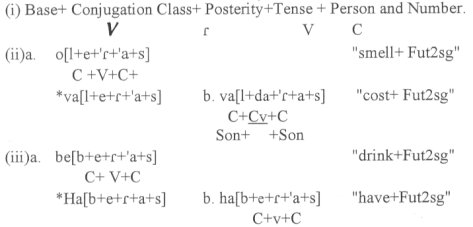
5.2.2 Plasticity or context sensitive integration
There are two cases which illustrate how in a morpheme which has a Vocoid, this Vocoid can be expressed in different shapes depending on the contingencies of the linguistic environment. The first case is a Vocoid which is in the same morpheme as the Obstruent and Rhotic, (intra-morphemic Vocoid). The second case is a Vocoid which is not in the same morpheme as the Obstruent and Rhotic (non-intra-morphemic Vocoid).
5.2.2.1 Intramorphemic Vocoid
In Spanish the rhoticity R element interacts with the Laterality L element at a higher level in a Liquid Li dissimilatory process (see 30c). Li participates in a combination process with Obstruency O forming an utterance initial cluster OLi. However spectrographic evidence suggests that Spanish Castilian Laterality does not co-occur with a svarabahakti in OLi clusters.1 In (6a'), the morpheme +OL+ shows Vowel harmony agreeing with the following interfixed morpheme +[i]+ when +dad+, a nominaliser, is combined with it.
| (6) | |
 |
I would suggest that the interconsonantal Vocoid of the morpheme +OL+ in (6a') is differentiated as Vowel but not as Place of articulation when L, which is clustering with O, secures a source of harmony for V from a morphological combination. This can be contrasted with a morpheme +simOL+ which does not show a differentiated Vocoid under the same circumstances of morphological combination (6b'). Both morphemes, however, exhibit an epenthetic Vocoid differentiated as a Vowel following the consonantal cluster when no morphological combination has been produced (6a,b).2
Now observe the following data.
| (7) | Some combinations of the Predicate "open" with other morphemes |
 |
In (7i,ii,iii) the undifferentiated Vocoid of this morpheme, VOR, is expressed as an unstressed svarabhakti agreeing with the Place of Articulation of the Vocoid in the adjacent following morpheme. In (7iv,v) the source of the agreement for the Vocoid is not immediately accessible in the following morpheme which contains an initial Consonant. In this non-agreement context, the undifferentiated Vocoid is expressed as either a Vowel, when unstressed (7iv), or as a prevocalic-postcononantal Glide when stressed (García-Bellido 1986, 2000). The undifferentiated Vocoid of this morpheme shows an effect of categorial instability by the fact that it has three categorial variants, {v,G,V}. Their categorial stabilisation depends on some regulatory mechanism which controls simultaneously two contingencies: whether there is a direct source for Vocoidal agreement and whether stress interacts, or combines with, the undifferentiated Vocoid.
5.2.2.2 Non-intramorphemic vocoid
This is the case of an inter-fixed Conjugation Class V which shows two categorial variants: svarabhakti (8iib,iiib) and Vowel (8iia,iiia). The Posterity morphemic construction in its [-Past] (Future tense) and its [+Past] (Conditional tense) is expressed by combining a Base together with a Person and Number (8i). The Posterity morpheme takes the phonological form of Rhoticity. In between the Base and the Posterity morpheme, there is a Conjugation Class expressed as a vocoidal interfix. This Vocoid takes either the form of a Vowel, spelling phonologically one out of three Conjugation classes I=[a], II=[e] or III=[i] (8iia,iiia) or else, the form of a svarabhakti (8iib,iiib). The specification of a precise Phonological category in the Conj.Class correlates with the particular base which is present.
| (8) | |
 |
The svarabhakti agrees with an adjacent Vocoid in the Tense, while the Vowel does not agree with any Vocoid. The presence of the svarabhakti in the Conj. Class and that of the Sonorant in the base "cost" (8iib) co-occurs with an epenthetic Consonant preceding the svarabhakti +Cv+. The epenthetic Consonant does not occur when the conjugation class of a specif morpheme "smell", "drink" is a Vowel (8iia) vs *[ol+de+R'a]s "smell", (8iiia) vs *b[eb+de+R'a]s "drink", or when there is no Vocoid between the Sonorant and a Rhotic: [al +re]dedor * a[l+d +re]dedor "around". The svarabhakti does not occur either when the morpheme +sub+ combines with a following morpheme starting with a rhotic s[ub+ra]yar *s[ub+d+ra]yar "under-lying". The presence of an epenthetic Consonant, specified as an Obstruent, but not as any other type, suggests that it is the co-occurrence of three phonological elements: Rhoticity (in Posterity), Sonorancy (in the base) and a svarabhakticity (in the conjugation class) which trigger the selection and addition of the Obstruent to be interfixed between the svarabhakti and the Sonorant base. The svarabhakti is therefore a non-intramorphemic Vocoid which functions morphologically as a Conjugation class but ends up integrating phonologically an Obstruent with a Rhotic when the base ends in a sonorant. The phonological function of the svarabhakti here is of a Stereo Antimirror Connector (see Z in (31a) below).
1 I owe this information to P.O'Neill.
2 The behaviour of laterality in Spanish requires a more extensive discussion
which cannot be pursued here.
Volumen 22 (2005) ISSN: 1139-8736 |